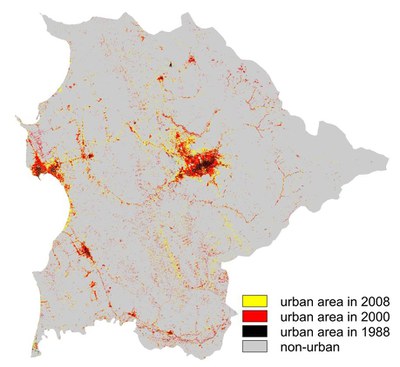Urban growth in greater Tirana
Support Vector Machines for modeling urban growth in Greater Tirana, Albania
(German: Support Vector Machines zur Modellierung der Urbanisierung im Großraum Tirana, Albanien)
The urban area of greater Tirana, Albania has faced dramatic changes in terms of area and population. With the collapse of the soviet system land management strategies have significantly changed from strictly restricted urban growth to extensive urbanization with large shares of unregulated land development. It is particularly demography and migration patterns which have significantly altered the city and the whole country. The rapid and frequently unregulated urban development has led to a dramatic decrease in agricultural land and provision of ecosystem services in greater Tirana region. Spatially explicit modelling can give new insights on past patterns and processes and may provide information on likely future developments to support decision-making.
The aim of this project is to analyse the benefits of a support vector machine approach for modelling urban land dynamics. A machine learning and data-driven approach such as support vector machines seems promising: Only little is known of the investigated land use change and SVMs offer the ability to learn from the data. Second, a challenging empirical dataset exists including restricted quality, large amounts of data and missing datasets which SVM seems to be able to address by its ability to deal with non-linear behaviour and shortcomings of data in a computational efficient way. We hence apply support vector machines to the greater Tirana region using land use data derived from a binary classification of Landsat data for 1988, 2001 and 2008. In addition environmental data, e.g. on elevation, slope, as well as socio-economic data on population figures are used and further processed to calculate neighbourhood and density measures. Benefits and challenges of support vector machines for modelling the spatio-temporal dynamics of urban growth are identified and discussed.

Principal Investigator:
Tobia Lakes (Geomatics Lab, Geography Department, Humboldt-Universität zu Berlin)
